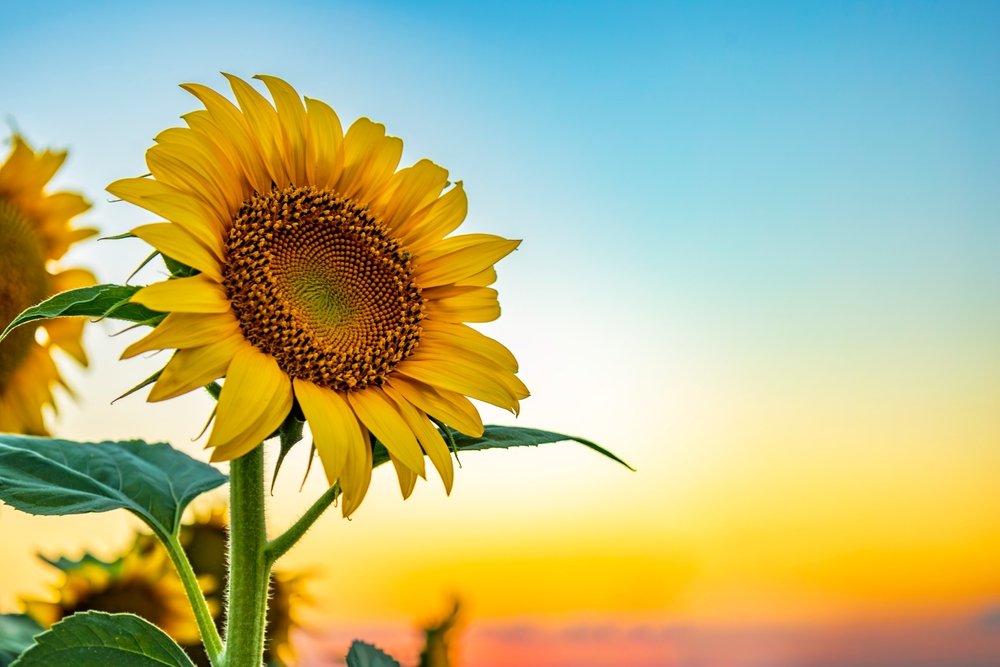Sunflower-Herointhus Annuus is much more than a brilliant bloom, looking at the sun, and is native to North America. A history is radiant as its golden petals: early cultivated in about 3000 B.C. by Indigenous tribes, sunflowers were then valued not because of their good looks, but of their edible seeds, medicinal effects, and dye extraction. Vagabonds into the world’s continents over the years from America to places where they gained cultural significance, such as Russia and Japan.
Ever before they decorated kitchen gardens and farm fields, sunflowers were prime examples of beneficial crops and symbolic plants. Their enviable ability to survive in all climates will make them a dependable crop and botanical phenomenon.
Heliotropism: The Dance With the Sun
This flower is heliotropic, which, as mentioned earlier, is a mesmerizing Ness function of sunflowers, of the capacity for the flower to follow the sun. Young sunflowers track the movement of the sun across the sky by day from east to west. At night, the flower reorients itself to the east so that it is ready to receive the dawn rays again. This facility has a plant internal circadian rhythm and most likely very complicated hormonal mechanisms that influence stem elongation.
The flower settles toward east at which the movement will cease. It is an evolutionary adjustment for the flower for it to attract pollinators that prefer heat on an early sunlit surface.
Symbolism and Cultural Importance Across the Globe
Across many cultures, the symbolic meaning of sunflower differs. The Chinese, for example, consider it a symbol of longevity and good fortune. The Victorians viewed the giving of sunflowers as an act of adoration, giving expression to loyalty and pure thoughts. In certain Native American traditions, sunflowers were viewed as representing harvest, bounty, and spiritual connection.
In modern times, sunflowers have evolved to become symbols encompassing happiness, positive energy, and peace. Ukraine, for instance, has adopted the sunflower as its national symbol, signifying resistance, hope, and solidarity.
Sunflowers in Art and Literature
What calls here more than any other, perhaps, is their presence in art and in literature; for, after all, one cannot in the above all hope to understand the secret life of sunflowers without exploring their own art and literature. What immortalized this flower was the series, “Sunflowers,” by Vincent van Gogh, making it an enduring symbol of artistic fervor and emotional expression. He makes us hear sunflowers in a poetic way the way many poets and writers have, as they use this flower to symbolize endurance, warmth, and inspiration.
From the brush strokes of Monet to modern photography, the sunflower enchants creative minds across time. Its bold shape, along with its brilliant color, makes it an apt visual metaphor for resilience as well as joy.
The Botanical Complexity of Sunflowers
Sunflowers are nonetheless botanical masterpieces, notwithstanding their appearance of simplicity. Although they seem to be single flowers, in fact, they are composite flower heads with hundreds sometimes even thousands of tiny individual blooms arranged in pattern spirals. These florets mature into seeds unfolded according to the Fibonacci sequence, a natural mathematical outline present in various living forms.
Each part of the sunflower performs a biological function: the broad leaves absorb as much sunlight as possible and the strong stem supports the heavy flower head. A complex design ensures the fulfillment of growth and sustainability.
Ecological Benefits and Agricultural Value
They are impressive fireflies and afford freshness to everything: beautiful sunflowers, a further dazzling bird of paradise among papery foliage, up-holding nectar-eating birds through visitation. Thick, deep, roots benefit air conditioning and moisture, gaining entry to deeper levels of soil and air, at the same time, preventing soil erosion and making it a great sustainable input into the systems of farming.
On an agricultural scale, it is generally bred for seed and oil production. The oil obtained from the oilseeds is spoilt for rich content from the vitamin E envelope, healthy fat soluble lipids, and antioxidants. Also, sunflower oil enjoys international acceptance in culinary and cosmetic it contains nutritious nondairy protein seeds.
Sunflowers and Climate Adaptability
When it comes to climate change, sunflowers offer hope. They have a very drought-resistant quality and fast maturity. They also have the ability to withstand pests. These features make them well suited to harsh conditions in various parts of the world. Now, biotechnologists are working on sunflower genetics and gene combinations for engineering more climate-resilient crops that will be crucial in improving food security around the world.
Sunflowers are also known for their excellent abilities for thriving in poor soil conditions. As such, they can be used in a phytoremediation process that removes toxins such as lead and arsenic from contaminated land. Hence, it becomes a great ally for cleanup operations in the environment.
Sunflowers in the World of Wellness
The sunflower, in its full glory of flower, is one of nature’s greatest gifts to humanity in its practice of holistic healing. Sunflower seeds contain good amounts of magnesium, selenium, and B vitamins, which promote heart health, brain function, and immune support.
Sunflower oil finds applications in skincare, with its anti-inflammatory properties soothing the itchiness and dryness of conditions like eczema and acne. It is also antioxidant-rich to support cellular health and has a lightweight texture that makes it ideal for sensitive skin.
The Surprising Uses of Sunflowers
Not just the oil and seeds, sunflowers are full of surprises with many usages. Their stalks can be converted into material for construction and biodegradable paper; petals are used to prepare natural dyes. Sunflower oil is now being compared as an eco-friendly Method for biodiesel production against fossil fuels.
Besides that, sunflowers are also bioassayed for scientific research, where one would study how a plant behaves under certain soil conditions and pollutant absorption. This makes it a prime candidate for experimental botany as it is resilient and sensitive to sunlight conditions.
The Emotional Connection: Why We Love Sunflowers
The human heart is attracted instinctively toward sunflowers. They are leaning upward in elation, radiating a golden hue of warmth, vigor, and optimism. Sunflowers are planted in fields, painted on canvases, and gifted in bouquets, creating an effect on the human psyche beyond aesthetic appreciation.
Their ability to turn toward light reflects our movement in search of purpose and growth. This ever-emanating emotional appeal is why the flower remains in the timeless realm of hope and happiness.
Conclusion: More Than Just a Flower
It narrated a story evolution of utility and symbolism even inspiration. The sunflower has always been there from the ancient civilizations up to the cutting-edge of modern science. It has not failed to influence agriculture, art, and human emotion. Such heritage and diversity of application would make this plant a perennial presence not only in nature but also in the fabric of our collective consciousness.
Also Read: Website DesignMode24.com: A Guide to Its Features & Benefits



